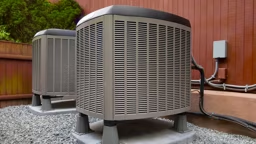
Written by Dennis Stinson, Vice President of Sales for Fujitsu General America
America’s log cabin homeowners can expect to shell out more cold cash to keep warm this winter as they face the highest home heating costs in more than a decade - making optimal energy efficiency more essential than ever.
Here are the financially frostbiting facts. The average cost of home heating is expected to increase by 17.2% since last winter from $1,025 to $1,202, according to the National Energy Assistance Directors Association (NEADA). Those who heat with natural gas will confront the largest spike with their cost predicted to soar 34.3% over last year. Conversely, homeowners who use electric heat are forecasted to see the lowest increase at 6.9%.
On the bright side, owners of log and timber homes have a natural advantage. Thermal mass, a natural property in logs that helps keep inside temperatures comfortable, allows walls to collect and store energy, then radiate it back into the home. In fact, homes built with solid log walls are typically 2.5% to 15% more energy efficient than standard stick-frame construction, according to an NAHB study.
The good news is that families can prevent a utility bill blitz by following a few simple tips on their own and seeking the expertise of an HVAC contractor to insure optimal home comfort. With home heating and cooling accounting for more than half (54%) of home energy use, small steps can go a long way.
Get “Smart" About Climate Control
When it comes to smart home temperature control, there are Smart HVAC Systems and Smart Thermostats. Smart HVAC systems have built-in Internet capability. Smart Home Thermostats create “smart” systems by enabling remote temperature control via a mobile or Internet-connected device or voice-operated home automation system.
Voice Your Preference
Most HVAC manufacturers offer apps that enable systems to be controlled from anywhere using a mobile device. Voice-control capability uses digital assistants, like Amazon Alexa or Google Home, to dictate home temperatures. Easily controlling the temperature more closely allows homeowners to be more comfortable and energy-efficient.
Find Your Efficient Comfort Zone
If you find yourself using a fraction of your home on a regular basis, consider upgrading to a zoned ducted, or ductless system. That will allow you to save energy heating and cooling spaces where you and your family don’t spend a lot of time.
Seal the Deal
Air infiltration is a particularly important factor for log and timber homes. Proper sealing between the foundation and the first course of logs, between log-to-log connections and where the roof system meets the log wall will optimize overall efficiency.
Turn it Down
Even a slight temperature decrease can make a difference. You can save as much as 10% a year on heating and cooling by simply adjusting your thermostat a mere seven-ten degrees for eight hours a day from its normal setting.
Work your Windows
About 30% of a home's heating energy is lost through windows. Open window coverings in the morning to allow the sun to heat your home through the day—especially those that receive direct sunlight.
Choose Coverings Wisely
Tightly installed cellular shades can reduce heat loss by 40%, which equates to about 10%heating energy savings. Heavier fabrics will typically offer slightly better thermal performance. Close all draperies at night.
Overall, a comprehensive, “whole-house” approach is best. By combining proper equipment maintenance and system upgrades with other easy elements homeowners can cut energy use by 20%-50%, according to the U.S. Department of Energy. A little knowledge can help homeowners make a significant difference when it comes to offsetting the profoundly off-putting cost of home heating this winter.











